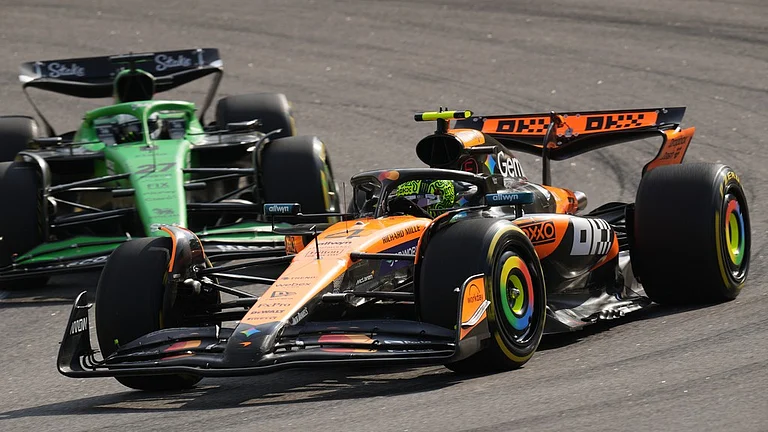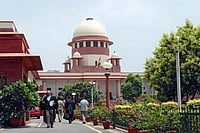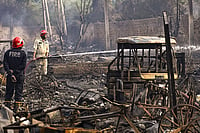An ill-fated love affair. Anger turned murderously inward. Alcohol. A hint ofnarcotics. An obsession with guns. All these combined in moments of ferocious andconvulsive violence, on June 1, as Nepals 29-year-old Crown Prince Dipendra went ona rampage in the billiard room of Narayanhiti Palace in Kathmandu and gunned down ninemembers of his family. He then apparently killed himself.
A young man hitherto described only as amiable, gentle and intelligentburst into a room wearing combat fatigues and holding two automatic rifles. Present therewas his father King Birendra, perhaps Nepals most loved monarch of modern times; hismother, Queen Aishwarya, a steely-eyed and much-feared guardian of the family; his youngerbrother Prince Niranjan, a well-liked 24-year-old who enjoyed partying with the Kathmanduelite; his sister Princess Shruti, a painter and a holder of a black belt in judo whocombined her mothers resolve with the warmth of her father; his uncle PrinceDhirendra, stripped of a royal title for marrying a foreigner but lately beingrehabilitated. They all succumbed to the princes murderous rage, his blazing machineguns. Others died toominor royals and their spouses and perhaps, an unknown numberof palace retainers and aides-de-camp. Even a constitutional monarchy needs its trappings,its batmen, its hangers-on.
When Nepalis awoke on June 2, an eerie silence in the streets greeted them, a sensethat something was horribly wrong. Those with access to the bbc, cnn and the Net heard atale that stretched credulity beyond breaking point: it was based on sourcesand insiders, some of them the same people who have gone public this week withtheir account of events inside the palace (see box). State radio and television playedonly Hindu devotional music.
Finally, a snippet of news post-lunch: the king was dead, so was the queen, long liveKing Dipendra. But wait, Radio Nepal had morethe new king was in a coma, and PrinceGyanendra, younger brother of the late King Birendra, would be regent. Grief and confusionburst through the dam of incomprehension that had so far held back emotions. The vaguestatement suggested there had been an event of momentous horror within the palace butprovided no explanation, no attempt to mitigate or deny international media and Nepaliwebsite reports that the new king had killed his parents and most of his family members.
A minister tried to appease the angry public. Speaking to a news agency, home and deputyprime minister Ram Chander Poudel said, The prince did it. He shot his family, thenshot himself. But he quickly withdrew his words. Privately, ministers and MPs werealready furious at the inept handling of the tragedy. If only Dipendra haddied, said one, then wed have only mourning and horror to contend with.Our constitution means we have to name a comatose man king, with so much blood on hishands. Its dreadful, dreadful. Nepals constitution of 1990 grantsabsolutely no discretion in the succession to the throneand the countrys elitewere keen to avoid the embarrassment of naming a murderer king.
The first spasms of violent disbelief hit the streetand got worse. On Sunday, theRoyal Regent, Prince Gyanendra, said thered been a sudden discharge ofautomatic weapons in the palace. Some saw an attempt to make the killings seem anaccident. The fact was officials wanted to control the news, hoping the new king wouldsuccumb to his injuries. Meanwhile, a grieving and increasingly angry publicmostlyyoung men glaring at the world from beneath tonsured scalpswas beginning to demandanswers, quite prepared as they were to believe the wildest of conspiracy theories.
No true Nepali can murder his parents, his brother, his sister, saidbusinessman Narayan Poudel, waiting to lay flowers at a makeshift shrine at the RoyalPalace. My king didnt do this, this is a lie and its aimed atundermining our country. Such feelingsunderstandable in the absence of aplausible official explanationboiled over on Monday, the day Dipendra died andGyanendra became the 12th member of the Shah dynasty to wear the lavishly-plumed crown ofthe 18th century founder of Nepal, Prithvi Narayan Shah.
The coronation was hasty. As the kings carriage wended its way from the old RoyalPalace in Durbar Square in old Kathmandu to the Chinese-built Narayanhiti palace, knots ofyoung men oozed from side streets, shouting slogans against the government, even the newking. Gyanendras son, Prince Paras, whose antics in night clubs and drunkenhit-and-run accidents occasionally made it to the newspapers, also incurred the mobswrath.
Another ominous element to emerge that day was the anger against India. Copies of TheSunday Times of India were burnt; a Star TV camera crew was jostled. The word was out:India was part of the conspiracy to annihilate the royal family.
The new king won himself breathing space with the announcement of a high-level commission,headed by Chief Justice Keshav Prasad Upadhya, to investigate the killings but its workwas delayed because one of its members, leader of the Opposition Madhav KumarNepalbrought in to lend more legitimacy to the processpulled out the followingday.
Eyewitness accounts of the killings began coming out on Thursday (see box) but Nepal isabuzz with denials and rumours. Its a frighteningly sensitive time. The country haslost its main symbol of unity, and its people are lashing out in all directions. There arefamiliar demonsIndia, the unpopular prime minister, Girija Prasad Koirala, and somenew onesthe international media, and, worryingly, the new king, Gyanendra.
By all accounts, King Gyanendra is a serious and dedicated man, and still deep in hisown sense of shock. Foreign diplomats in Kathmandu say Gyanendra may be one of the brightspots of this gloomy scenario. Hes a hands-on fellow, a good administrator,likes to take charge from the front, said one envoy, requesting anonymity. ButI dont think hes authoritarian. Hes said he supports democracy. Thebiggest worry is his son.
Prince Paras Shah, a royal partygoer with a violent streak, is now next in line to thethrone though his father is yet to name him Crown Prince. Theories that Paras was behindthe killings in the palace, or that he encouraged Dipendra to murder his parents, arewidely believed but wildly implausible. In fact, eyewitnesses to the killings have nothingbut praise for his role. But even this is seen to be part of a grand conspiracy.
One force in this crisis that frightens the Nepali elite is the militant Maoistmovement that has established its sway over five of the countrys 75districtsand is still growing rapidly. Arch republicans who want to end the royalfamilys role, the Maoists praised the late King Birendra for his liberal andpatriotic ideology and accused anyone who believed Dipendra had killed his father tobe part of a conspiracy involving Girija (Prasad Koirala), India and internationalreactionary forces.
Theres no doubt that Maoist supporters helped fan the flames of fury thatfollowed King Gyanendras coronation. The current crisis presents an opportunity tothe group to exploit urban anger and angst and spread beyond rural Nepal. And thegovernment demonstrated its fear of them through its decision to arrest one ofNepals most respected journalists, Yubaraj Ghimire, who published in his newspaperMaoist leader Baburam Bhattarais article asking the Royal Army to rise against anillegitimate king and government. It was terrible timing, to publishsomething so inflammatory when the nation is in crisis, comments a fellow editor,but to charge them with sedition is all wrong. The government needs friends in thepress now, not enemies.
For the most part, a version of normal life is returning to Nepal. Officialmourningironically now for the late King Dipendraends on Sunday night. Shopsare gradually reopening and the curfews and riots that paralysed Kathmandu earlier duringthe crisis havent been repeated. The official inquiry commission is to finish itswork this weekend and according to government sources, the results will be made publicimmediately.
Their job has been made easier by the wide coverage of revelations of eyewitnesses. Asilent, reasonable majority in Nepal might just reassert itself as schools reopen andpeople return to office. But this nation has had its heart ripped out. After the bitterand violent Jana Andolan that brought multi-party democracy in 1990, Nepalis thought theyhad found the perfect system: constitutional monarchy allowed the king to unify anethnically diverse people without hampering the elected government to run the country.Eleven years of democracy havent been a happy experience but the monarchy grew inpublic esteem. Lately, political infighting, ineptitude and rampant corruption hasembittered even ardent supporters of democracy. Now with even the monarchy intattersan unproven king with an unpopular heirwhere can Nepalis turn? To theMaoists or to attempts at political reconciliation?

























